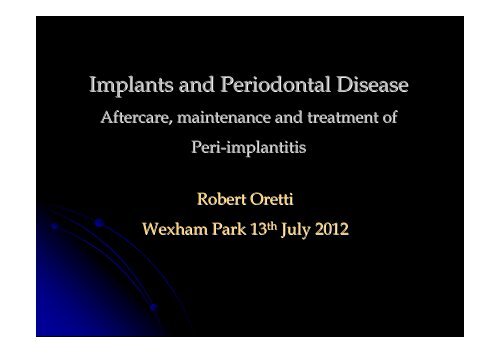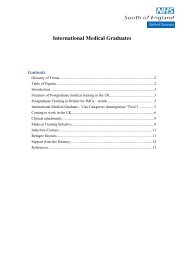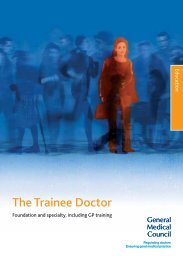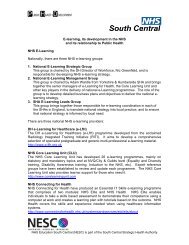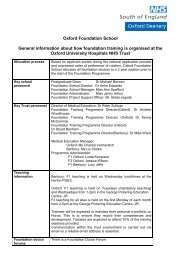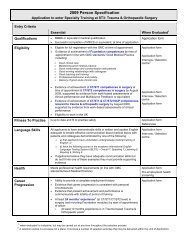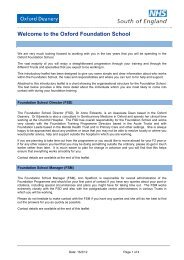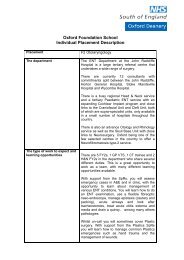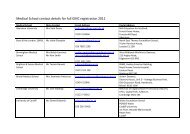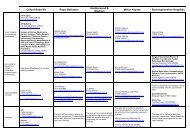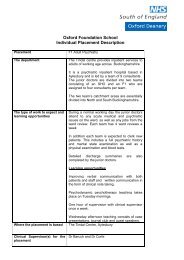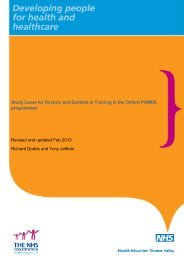Implants and Periodontal Disease - Oxford Deanery
Implants and Periodontal Disease - Oxford Deanery
Implants and Periodontal Disease - Oxford Deanery
Create successful ePaper yourself
Turn your PDF publications into a flip-book with our unique Google optimized e-Paper software.
<strong>Implants</strong> <strong>and</strong> <strong>Periodontal</strong> <strong>Disease</strong><br />
Aftercare, maintenance <strong>and</strong> treatment of<br />
Peri-implantitis<br />
Peri implantitis<br />
Robert Oretti<br />
Wexham Park 13 th July 2012
Pentangle Dental Transformations<br />
Implant referral centre established in 2006<br />
www.pentangledental.co.uk
Pentangle Dental Transformations
Pentangle Dental Transformations<br />
We are 95% referral-based specialist<br />
practice.<br />
We have 150 referring dentists.<br />
We receive 50 referrals a month .<br />
85% of our work involves dental<br />
implants.<br />
15% are referred for other treatments –<br />
mainly an aesthetic improvement<br />
involving ortho/restorative.<br />
5% are ‘word of mouth’ self referred.
The Right Team
Peri-Mucositis<br />
Peri Mucositis <strong>and</strong> Peri-Implantitis<br />
Peri Implantitis<br />
•Prevalence Prevalence<br />
•Differential Differential Diagnosis<br />
•Aetiology Aetiology<br />
•Confounding Confounding (risk) Factors<br />
•Identification<br />
Identification<br />
•Prevention Prevention
7 year review
Early 18 months bone loss later…..are with no gingival the tissues inflammation 4 year healthy review ?
•Prevalence Prevalence<br />
Prevalence <strong>and</strong> risk variables for peri-implant disease<br />
S. D. Ferreira G. L. M Silva<br />
Journal of Clinical Periodontology 2006<br />
212 subjects (smokers were excluded) with a total of 578 implants<br />
were evaluated three <strong>and</strong> a half years later…..<br />
73.5% of subjects presented with peri-implant BOP<br />
64.6% with peri-implant mucositis<br />
8.9% with peri-implantitis
Extent of peri-implantitis-associated bone loss<br />
Tord Berglundh<br />
Journal of Clinical Periodontology 2009<br />
1070 implants examined at the ten year mark.<br />
(No note was made of the incidence of peri-mucositis)<br />
The study was to examine pathological bone loss<br />
419 of the 1070 implants exhibited peri-implantitisassociated<br />
bone loss……....40%
Peri-implant diseases : Consensus Report of the Sixth European<br />
Workshop on Periodontology<br />
Jan Lindhe Joerg Meyle<br />
Journal of Clinical Periodontology 2008<br />
One study included a review of 3,413 implants<br />
assessed at the five year mark……..<br />
Peri-implant mucositis occurred in about 80% of<br />
subjects restored with implants.<br />
Peri-implantitis occurred in between 28% <strong>and</strong> 56%
Peri-implant Peri implant diseases are defined as an infection of the<br />
tissues around a functioning implant.<br />
Risk factors are :<br />
poor oral hygiene<br />
Sub-gingival dental plaque<br />
a history of periodontitis<br />
smoking<br />
diabetes.<br />
alcohol consumption<br />
……..<strong>and</strong> time
‘’Triggering factors for peri-implantitis are generally<br />
gathered under four categories:<br />
Lesions of peri-implant attachment (poor oral hygiene)<br />
Presence of aggressive bacteria (subgingival dental plaque)<br />
Excessive mechanical stress (functional overloading)<br />
Corrosion (early or late implant contamination)<br />
If only one of these factors would start a chain reaction<br />
leading to lesions, then the other factors may combine to<br />
worsen the condition. In other words, peri-implantitis is a<br />
general term dependent on a synergy of several factors,<br />
irrespective of the precise reason for the first triggering of<br />
symptoms.’’<br />
Tomas Albrektsson 2009
Peri-Mucositis<br />
Peri Mucositis <strong>and</strong> Peri-Implantitis<br />
Peri Implantitis<br />
•Prevalence Prevalence<br />
•Differential Differential Diagnosis<br />
•Aetiology Aetiology<br />
•Confounding Confounding (risk) Factors<br />
•Identification<br />
Identification<br />
•Prevention Prevention
Bone Loss around implants<br />
Causes of early bone loss…..<br />
•Bone trauma during implant placement<br />
Over-heating.<br />
Excessive bone compression.<br />
Excessive bone distraction (ridge splitting).
Bone Loss around implants<br />
Causes of early bone loss…..<br />
•Bone trauma during implant placement<br />
• Inadequate residual bone thickness after implant placement.
Bone Loss around implants<br />
Causes of early bone loss…..<br />
•Bone trauma during implant placement<br />
• Inadequate residual bone thickness after implant placement.<br />
•Excess cement pushed down around implant head.<br />
•Aggressive peri-implantitis ?
Cementation issues<br />
8mm pocket distally<br />
Who is liable for the new implant later on ?
Another case example<br />
Healed implant after 8 weeks At one year recall – cement<br />
<strong>and</strong> bone loss seen
One solution – set abutment margins at, or above,<br />
gingival level to control flow of cement excess
Cementation issues
Sometimes bone may be hard <strong>and</strong><br />
relatively avascular<br />
35 year old man<br />
Lower first molar site<br />
Extremely hard cortical<br />
bone, avascular<br />
CT scan gives a<br />
Hounsfield unit density<br />
score of 1464<br />
(Type 1 bone about 1000)
Surgical trauma was induced<br />
within the bone crest, visible<br />
at 8 weeks.<br />
Crestal bone loss resulted.
60 year old woman wishes to dispense with single<br />
tooth denture
Aggressive periodontitis ??<br />
Allergic to titanium ?
3 month rev
Bone Loss around implants<br />
Causes of Late bone loss…..<br />
•Non passivity of fit of supra-structure.<br />
• Peri-implantitis.<br />
•Occlusal trauma ?
Non- Non passivity of fit – particularly large spans
Peri-Mucositis<br />
Peri Mucositis <strong>and</strong> Peri-Implantitis<br />
Peri Implantitis<br />
•Prevalence Prevalence<br />
•Differential Diagnosis<br />
•Aetiology Aetiology - Bacterial<br />
•Confounding Confounding (risk) Factors<br />
•Identification<br />
Identification<br />
•Prevention Prevention
What is Peri-implantitis<br />
Peri implantitis?<br />
An inflammatory process affecting the tissues<br />
around an osseo-integrated implant in function<br />
<strong>and</strong> resulting in the loss of supporting bone.<br />
The aetiology is of a bacterial nature with<br />
characteristics similar to periodontitis.<br />
Pain is not normally a feature <strong>and</strong> frequently<br />
the patient is unaware of any problems.<br />
You have to have started with a peri mucositis<br />
– although this key indicator is difficult to<br />
diagnose.<br />
Peri-implantitis is more aggressive <strong>and</strong><br />
progresses faster than periodontitis.
The Pathway……<br />
Pathway……<br />
A dental implant is a type 3 medical device : it<br />
crosses the epithelial barrier into a non sterile<br />
environment.<br />
Exposure to micro-organisms is therefore<br />
inevitable <strong>and</strong> a biofilm will form readily –<br />
even on smooth surfaces.
The Pathway……<br />
Pathway……<br />
A dental implant is a type 3 medical device : it<br />
crosses the epithelial barrier into a non sterile<br />
environment.<br />
Exposure to micro-organisms is therefore<br />
inevitable <strong>and</strong> a biofilm will form readily –<br />
even on smooth surfaces.<br />
Colonisation – proliferation – increased oxygen<br />
dem<strong>and</strong> – anaerobic proliferation – host<br />
response elicited – mucositis.<br />
Mucositis is an opportunistic infection borne out of<br />
a change in the environment <strong>and</strong> results in an<br />
inflammatory lesion which resides in the mucosa<br />
only
BLEEDING ON PROBING
The Pathway……<br />
Pathway……<br />
You can <strong>and</strong> must probe around dental<br />
implants.<br />
Inflammation around implants is harder to see<br />
clinically.<br />
Bleeding indicates that some form of<br />
interceptive treatment is required.<br />
Becker et al found that at five year recall of all implant<br />
patients, 80% presented with bleeding on probing.<br />
Up to 40% of these cases presented with some<br />
degree of peri-implantitis.
Peri-Mucositis<br />
Peri Mucositis <strong>and</strong> Peri-Implantitis<br />
Peri Implantitis<br />
•Prevalence Prevalence<br />
•Differential Differential Diagnosis<br />
•Aetiology Aetiology - Bacterial<br />
•Confounding Confounding (risk) Factors<br />
•Identification<br />
Identification<br />
•Prevention Prevention
Diabetes mellitus is a chronic metabolic disorder that affects more<br />
than 11% of the adult population.<br />
This prevalence represents a 28% increase in the number of patients<br />
with diabetes since 2005 (CDC 2005, 2008).<br />
Current projections of diabetes incidence suggest that as much as 33%<br />
of the population may be diagnosed with diabetes by 2050, with type 2<br />
diabetes mellitus accounting for 90–95% of all diabetes patients (Boyle<br />
et al. 2010). Worldwide, over 150 million people were estimated as<br />
having diabetes in the year 1980, <strong>and</strong> that number had grown to over<br />
350 million by 2008 (Danaei et al. 2011).<br />
Taken together, these trends highlight the urgency for a better<br />
underst<strong>and</strong>ing of diabetes as well as for improving the care of patients<br />
with diabetes.
Effects of diabetes mellitus on periodontal <strong>and</strong> peri-implant conditions:<br />
update on associations <strong>and</strong> risks<br />
Giovanni E. Salvi1, Niklaus P. Lang<br />
<strong>Periodontal</strong> diseases represent chronic inflammatory responses to a<br />
bacterial challenge. Although bacterial biofilms have been shown to be<br />
necessary in the initiation of gingival inflammation <strong>and</strong> subsequent<br />
destruction of periodontal tissues, its presence alone explains a relatively<br />
small proportion (i.e. 20–30%) of the variance in disease expression<br />
Based on an established model of pathogenesis, the bacterial biofilm alone<br />
is insufficient to explain disease initiation <strong>and</strong> progression. Evidence<br />
suggests that periodontal tissues destruction is mainly due to the host's<br />
inflammatory response to the bacterial challenge.<br />
In addition to other factors, diabetes mellitus has been shown to modify<br />
the host response to the bacterial challenge <strong>and</strong> in time may increase the<br />
risk for periodontal disease
The findings indicated that diabetes did not represent an absolute<br />
contraindication for implant placement, provided that there was good<br />
glycaemic control.<br />
However, implants in diabetic subjects were significantly associated<br />
with an increased risk for peri-implantitis compared with implants<br />
placed in non-diabetic subjects (Ferreira et al. 2006).
Smoking interferes with the prognosis of dental implant treatment: a<br />
systematic review <strong>and</strong> meta-analysis<br />
Frank Peter Strietzel, Peter A. Reichart<br />
The increased risk of wound healing complications as well as the risk<br />
of peri-implant bone loss <strong>and</strong> increased implant failure rates have to<br />
be emphasized.<br />
Impaired wound healing has to be expected due to less collagen<br />
production, reduced peripheral blood circulation <strong>and</strong> compromised<br />
function of polymorphonuclear leucocytes <strong>and</strong> macrophages.<br />
Although not completely investigated, the known mechanisms of<br />
action of smoking on periodontitis were found to be the long-term<br />
chronic effect due to impairing the vasculature of periodontal tissues<br />
<strong>and</strong> affection of multiple functions of neutrophils <strong>and</strong> inflammatory<br />
response as well as impairment of fibroblasts.
Smoking <strong>and</strong> Implant Failure<br />
Sanchez-Perez.A<br />
Sanchez Perez.A et Al. 2007 – A 5 year study<br />
Non-smokers Non smokers had a success rate of 98.6%<br />
Light Smokers (
•Very poor oral hygiene was highly associated with<br />
the presence of peri-implantitis.<br />
•Individuals with periodontitis were more likely to<br />
develop peri-implant inflammatory lesions - the<br />
presence of residual periodontal pockets represent<br />
niches of infection for adjacent implants.<br />
•Presence of periodontitis <strong>and</strong>/or smoking <strong>and</strong>/or<br />
diabetes were statistically associated with increased<br />
risk of peri-implantitis.<br />
•Additional variables were the time elapsed since<br />
implant placement <strong>and</strong> the frequency of visits for<br />
maintenance care.
Peri-Mucositis<br />
Peri Mucositis <strong>and</strong> peri-Implantitis<br />
peri Implantitis<br />
•Prevalence Prevalence<br />
•Differential Differential Diagnosis<br />
•Aetiology Aetiology - Bacterial<br />
•Confounding Confounding (risk) Factors<br />
•Identification<br />
Identification<br />
•Prevention Prevention
x<br />
Mucositis<br />
How can interproximal brushes be effective ?
Peri-implantitis
•Histologically there is a 3–4 mm width of biological soft tissue coverage<br />
over the implant-supporting bone.<br />
•While the outer zone of the connective tissue is well vascularized with<br />
fibres running in different directions, the inner zone is poorly vascularized<br />
<strong>and</strong> consists of collagen fibres running close to the implant surface in a<br />
parallel direction.<br />
•The peri-implant mucosa is therefore recognized as scar tissue, exhibiting<br />
an impaired resistance to bacterial colonization……………. <strong>and</strong> probing
•The gingival tissues around all implant restorations should be checked<br />
for health by probing …..irregardless of the outward appearance.<br />
•Probing the tissues is the first procedure to determine health or<br />
otherwise. Bleeding on probing (BOP) is always present with peri-implant<br />
disease.<br />
•Probing around implants using a moderate force (0.5N) will cause<br />
damage to the peri-implant mucosal seal <strong>and</strong> will penetrate to the periimplant<br />
marginal bone – particularly if the tissues are inflamed.<br />
•A light probing force of 0.25 N will not cause damage to the peri-implant<br />
tissues <strong>and</strong> complete reformation of the mucosal seal after 5 days will<br />
occur.<br />
•In health, you will not be able to penetrate more than 2mm <strong>and</strong> there<br />
will be no BOP. If the probing depth is 3-4mm (maximum) with BOP then<br />
the diagnosis is peri-mucositis……….<strong>and</strong> ??
•Other clinical signs could include reddened or oedematous tissues,<br />
recession or frank suppuration.<br />
•X-rays may need to be taken........how often ?<br />
•Reference to baseline measurements are essential to determine progress<br />
of peri-implant disease.<br />
•Once peri-mucositis is present, it is common to see it again on recall.<br />
Commonly, the BOP <strong>and</strong> the probing depth has increased
Peri-Mucositis<br />
Peri Mucositis <strong>and</strong> Peri-Implantitis<br />
Peri Implantitis<br />
•Prevalence Prevalence<br />
•Differential Differential Diagnosis<br />
•Aetiology Aetiology - Bacterial<br />
•Confounding Confounding (risk) Factors<br />
•Identification<br />
Identification<br />
•Prevention Prevention
•Firstly gently probe with very light pressure – do not force the probe –<br />
<strong>and</strong> measure the depth <strong>and</strong> then remove.<br />
•If there is BOP after probe removal - but you are no more than 4mm<br />
within the tissues – this is mucositis.<br />
•This is the precursor to peri-implantitis <strong>and</strong> this is the only stage that is<br />
reversible.<br />
•Explain the aetiology (biofilm build up) to the patient <strong>and</strong> the<br />
m<strong>and</strong>atory requirement for the patient to clean subgingivally <strong>and</strong> disrupt<br />
the biofilm.<br />
•Persistent biofilm presence <strong>and</strong> BOP will lead to bone loss probably<br />
within five years.
The Solution……<br />
Solution……..<br />
..<br />
Disrupt the biofilm….subgingival cleaning at every<br />
dental appointment – irrespective of whether<br />
bleeding on probing is present or not - to eliminate<br />
the reservoir of pathogens <strong>and</strong> return homeostasis.<br />
Hydrogen peroxide irrigation is excellent<br />
at destroying the anaerobic population
The Solution……<br />
Solution……..<br />
..<br />
The patient must be instructed in the daily use<br />
of aggressive crevice cleaning with small<br />
brushes, ‘sharpened’ end tufted brushes,<br />
interproximal brushes <strong>and</strong> ‘rough’ floss.
The Solution……<br />
Solution……..<br />
..<br />
You should clean the submucosal area using<br />
these oral hygiene aids to remove the biofilm<br />
<strong>and</strong> to teach the patient the correct homecare<br />
regime.<br />
This may be all that is required at this stage<br />
without the need for further instrumentation.
The Solution……<br />
Solution……..<br />
..<br />
However, can you use h<strong>and</strong> scalers <strong>and</strong><br />
ultra-sonics ?<br />
St<strong>and</strong>ard stainless steel hygienist instruments cannot be used as<br />
they will scratch <strong>and</strong> damage the titanium - any metal-to-metal<br />
contact will lead to a roughened implant surface <strong>and</strong> an<br />
environment that may allow the tenacious adherence of a<br />
bacterial biofilm to reform.<br />
However, the use of ultrasonics is recognised as a superior<br />
technique for biofilm disruption due to cavitation <strong>and</strong> acoustic<br />
microstreaming<br />
Plastic coated or titanium ultrasonic tips are recommended.
The Solution……<br />
Solution……..<br />
..<br />
Patients are not very good at cleaning subgingivally <strong>and</strong><br />
it is a skill they must acquire.<br />
no amount of instrumentation will resolve peri-implant<br />
inflammation (or periodontitis) if the oral hygiene<br />
remains poor <strong>and</strong> bleeding scores remain high.<br />
After cleaning <strong>and</strong> irrigating the subginival area, the<br />
patient should go away attempting to keep the area<br />
clean <strong>and</strong> inspection should be carried out 6 months later<br />
(dentist or hygienist)<br />
The biofilm will return but no bleeding on probing<br />
indicates homeostasis.<br />
Continued BOP requires revalidation of the above <strong>and</strong><br />
introduction of local antimicrobials – dentomycin ?<br />
As soon as probing is +4mm or x-rays confirm bone loss<br />
then we are now beyond simple management
Peri-implantitis<br />
Peri implantitis<br />
Mild, moderate <strong>and</strong> advanced forms of peri-implantitis<br />
occur in 28% - 56% of implant patients.<br />
History of previous periodontitis - even in previously<br />
treated patients.<br />
Poor oral hygiene.<br />
Smokers <strong>and</strong> poorly controlled diabetics.<br />
<strong>Implants</strong> in place longer than seven years.<br />
Patients will exhibit more peri-implantitis the longer<br />
they have had their implants<br />
More likely now that all implants have rough rather<br />
than machined surfaces<br />
Poor prosthetic design.
Histopathology of Peri-implantitis<br />
Peri implantitis<br />
X-rays are required to confirm if bone loss has occurred<br />
– the key indicator of peri-implantitis.<br />
Vertical destruction of the crestal bone – often saucer<br />
shaped.<br />
Mild peri-implantitis : up to 2mm bone loss.<br />
Moderate peri-implantitis : up to 4mm bone loss.<br />
Advanced peri-implantitis : over 5mm bone loss.<br />
Suppuration may be present in all three types.
C.I.S.T.<br />
Cumulative Interceptive Supportive Therapy<br />
Cleaning<br />
Irrigation<br />
Sterilisation<br />
Treatment
C.I.S.T.<br />
Cumulative Interceptive Supportive Therapy<br />
Cleaning<br />
The disturbance <strong>and</strong> removal of the bacterial biofilm in<br />
the peri-implant pocket - with instrumentation,<br />
polishing <strong>and</strong> thorough re-instruction of OH.<br />
Definitive treatment for non-mucositis, mucositis<br />
<strong>and</strong> phase I of treatment for mild/moderate periimplantitis.<br />
The role of the GDP’s GDP s practice ??
C.I.S.T.<br />
Cumulative Interceptive Supportive Therapy<br />
Irrigation<br />
The disturbance <strong>and</strong> removal of the bacterial<br />
biofilm in the peri-implant pocket.<br />
Saline, Chlorhexidine, Hydrogen peroxide,<br />
Tetracycline solution<br />
Definitive treatment for mucositis <strong>and</strong> phase II<br />
of treatment for mild/moderate periimplantitis<br />
Ultrasonics – inform patients that gingival recession may<br />
occur
Pus exudate is suggestive of an aggressively<br />
destructive process<br />
These implants were extracted
C.I.S.T.<br />
Cumulative Interceptive Supportive Therapy<br />
Sterilisation<br />
To decimate the bacterial challenge.<br />
Infection control with Dentomycin/Actisite local antimicrobial<br />
delivery systems.<br />
500mg Amoxicillin <strong>and</strong> 400mg Metronidazole TDS for<br />
seven days.<br />
Laser Therapy<br />
Phase III of treatment for mild/moderate peri-implantitis<br />
: Decontamination <strong>and</strong> conditioning of the implant<br />
surface.
C.I.S.T.<br />
Cumulative Interceptive Supportive Therapy<br />
Treatment<br />
Bone loss of 4mm or higher from the implant head.<br />
Rough surface implants cannot be cleaned<br />
effectively with antimicrobials –<br />
Ultrasonics, diamond burs<br />
Require visual inspection - raise a flap<br />
Phase IV of treatment for moderate/advanced<br />
peri-implantitis
What is good for initial clot <strong>and</strong> bone matrix aggregation is also<br />
good for future bacterial biofilm adhesion!
Treatment aims: Peri-implantitis<br />
Peri implantitis<br />
Remove all granulation tissue<br />
‘deep clean’ implant surface with microabrasion<br />
<strong>and</strong> soak in ‘chemicals’ <strong>and</strong>/or<br />
antimicrobials.<br />
Polish the implant surface clean ??<br />
Resective or regenerative surgery, or<br />
explantation<br />
Dependant on whether the site can be adequately<br />
maintained by oral hygiene measures<br />
Aesthetics ??
Peri-implant diseases – Consensus report of the sixth<br />
European workshop on Periodontology Lindhe. J 2008<br />
Despite the number of differing treatment approaches utilised :<br />
Non-surgical debridement with or without the use of local <strong>and</strong>/or systemic<br />
antibiotics<br />
Laser treatment<br />
Access flaps combined with antimicrobial therapy <strong>and</strong> regenerative<br />
procedures<br />
None of the above treatment procedures provided evidence corroborating<br />
their long term predictability.<br />
Access flaps with systemic antibiotics demonstrated a 58%<br />
resolution at 5 year follow up. Leonhardt A 2003
Successful management of peri-implantitis<br />
peri implantitis with a<br />
regenerative approach Froum 2012<br />
Anti- infective regime approach :<br />
Surgical access for debridement <strong>and</strong> decontamination<br />
Detoxification of the implant surface<br />
Guided bone regeneration <strong>and</strong> re-osseointegration<br />
Average bone gain was 3.5mm – at 3 to 7.5 year follow up<br />
Difficult to achieve more ?
The non-surgical treatment of peri-implantitis, including a mechanical<br />
treatment alone or combined with antiseptics or antibiotics can improve<br />
clinical parameters in the short term but residual defects may still persist.<br />
Surgical treatment such as guided bone regeneration may result in a gain of<br />
clinical attachment level <strong>and</strong> bone reconstruction in the long term.<br />
The limited effect of laser-assisted therapy needs to be further evaluated.<br />
The concept of prevention based on early detection <strong>and</strong> regular<br />
maintenance plays a principal role in reducing the occurrence of periimplantitis.
OH Measures<br />
Fine tufts <strong>and</strong> ‘rough rough’ floss subgingivally.<br />
subgingivally<br />
Dipped in Corsodyl gel<br />
Syringe gel into crevices<br />
Patient to continue at home<br />
Recommendation is three monthly<br />
hygiene maintenance …..for life
Care <strong>and</strong> Maintenance of the patient<br />
Overview<br />
Like all expensive things, implants need to be looked after.<br />
Maintenance of oral hygiene <strong>and</strong> monitoring is essential.<br />
The assumption that implants are indestructible <strong>and</strong> further care is not<br />
required must be removed from the patient’s mind.<br />
Implant/crowns should be monitored just like natural teeth – every six<br />
months.<br />
X-rays should be taken annually at first <strong>and</strong> then every three years.<br />
Hygienist appointments will be dependant on the patients presentation<br />
but will probably be bi-annual.<br />
For the healthy implant, customised end-tufted brushes <strong>and</strong> sub-gingival<br />
flossing are the most useful for gum crevice cleaning.<br />
Implant gum crevices are deeper – approx 4mm<br />
4 yr review
Patients must never be allowed to abdicate<br />
their responsibility for looking after their<br />
implants…..<br />
implants ..
E-mail address :<br />
consulting1@pentangledental.co.uk


